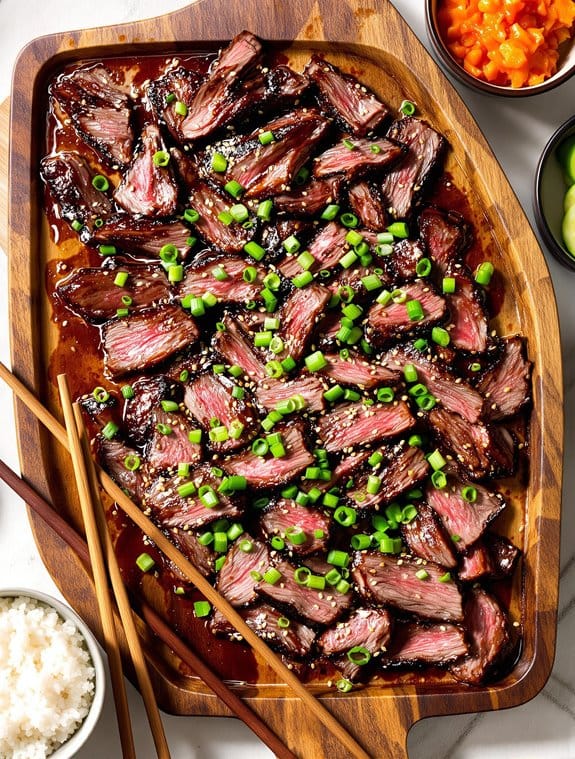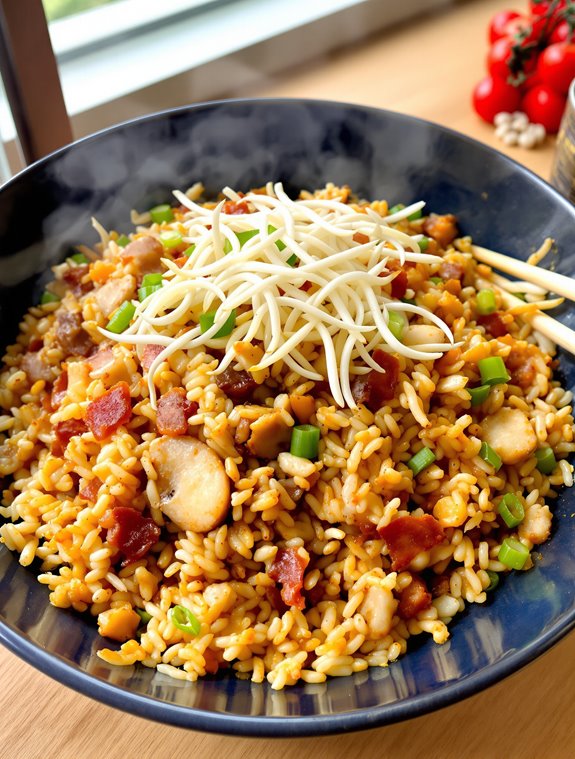Why You’ll Love this Authentic Korean Bulgogi
When you try this authentic Korean bulgogi recipe, you’ll understand why it’s been a beloved dish for centuries. The tender strips of beef, kissed with a perfect balance of sweet and savory flavors, simply melt in your mouth.
I’m obsessed with how the marinade works its magic, transforming even tougher cuts into succulent bites. What’s not to love? The sesame-soy-ginger combo creates that unmistakable Korean flavor profile, while the hint of sweetness from brown sugar caramelizes beautifully on the grill.
Trust me, your kitchen will smell incredible. The best part? It’s surprisingly simple to make at home.
What Ingredients are in Authentic Korean Bulgogi?
The magic of Korean bulgogi lies in its perfect balance of ingredients. Each component plays a vital role in creating that mouthwatering flavor profile that’s simultaneously sweet, savory, and umami-rich.
When I gather ingredients for bulgogi, I always get excited knowing the incredible transformation that’s about to happen to a simple cut of beef. The marinade ingredients work together to tenderize the meat while infusing it with that distinctive Korean flavor that’s impossible to resist.
- 4 pounds short rib of beef (tri tip or flank steak work well too)
- 1/2 cup soy sauce
- 1/2 cup water
- 1/4 cup sesame oil
- 2 1/2 tablespoons packed brown sugar
- 2 tablespoons lightly toasted and crushed sesame seeds
- 2 garlic cloves, crushed
- 1 tablespoon freshly grated ginger
- 2/3 cup thinly sliced green onions
- 1/2 teaspoon red pepper flakes
- 1/8 teaspoon ground Szechwan pepper
When selecting beef for bulgogi, the cut matters almost as much as the marinade. Short ribs offer a wonderful marbling of fat that keeps the meat juicy, but don’t worry if you can’t find them—tri tip and flank steak are excellent alternatives.
Just remember to slice against the grain for maximum tenderness, no thicker than 1/2 inch. And while we’re talking substitutions, you can adjust the red pepper flakes to your heat preference. Want it milder? Use less. Craving that signature Korean heat? Feel free to add a touch more.
The beauty of this recipe is how adaptable it’s while still maintaining its authentic character.
How to Make this Authentic Korean Bulgogi

Making bulgogi is a straightforward process that yields incredible results. Start by trimming your 4 pounds of beef (short rib, tri tip, or flank steak) into pieces no thicker than 1/2 inch. This thinness is vital—it allows the marinade to penetrate deeply and guarantees quick, even cooking. If you’re using tri tip or flank steak, remember to slice against the grain; this simple technique breaks up the muscle fibers and results in meat that practically melts in your mouth.
The marinade is where all the magic happens. In a large ziplock bag, combine 1/2 cup soy sauce, 1/2 cup water, 1/4 cup sesame oil, 2 1/2 tablespoons packed brown sugar, 2 tablespoons toasted and crushed sesame seeds, 2 crushed garlic cloves, 1 tablespoon grated fresh ginger, 2/3 cup thinly sliced green onions, 1/2 teaspoon red pepper flakes, and that tiny but mighty 1/8 teaspoon of ground Szechwan pepper. Seal the bag and give it a good massage until everything is well mixed—this is oddly satisfying, I must admit.
Then add your beef slices, seal again, and massage some more until every piece is thoroughly coated. Pop it in the refrigerator for 4-6 hours, turning occasionally to guarantee even marination. Can you smell that incredible aroma developing yet?
When you’re ready to cook, you have several options. Traditional bulgogi is grilled over high heat, which creates those wonderful charred edges and smoky flavor notes. But don’t worry if you don’t have access to a grill—broiling or even pan-frying works beautifully too.
The thin slices cook quickly, typically 3-6 minutes per side depending on thickness. Here’s a pro tip: don’t discard that marinade! Pour it into a small bowl and brush it onto the meat when you flip it. This basting step adds an extra layer of flavor and helps create that glossy, caramelized finish that makes authentic bulgogi so irresistible.
Authentic Korean Bulgogi Substitutions and Variations
Although traditional Korean bulgogi follows specific ingredients and methods, you’ll be delighted to know that this versatile dish welcomes substitutions based on what’s available in your pantry or dietary preferences.
Don’t have short ribs? No problem. Ribeye, sirloin, or even thinly sliced pork work beautifully.
Vegetarians can try firm tofu or meaty portobello mushrooms—just reduce the marinating time to avoid mushiness.
Out of brown sugar? Honey or maple syrup creates a lovely glaze. I sometimes add grated Asian pear for tenderizing or pineapple juice for sweetness.
Want it spicier? Double those red pepper flakes. The marinade adapts to your taste.
That’s the beauty of bulgogi.
What to Serve with Authentic Korean Bulgogi
Traditional Korean bulgogi pairs up beautifully with an array of side dishes that complement its sweet, savory flavors. I always serve mine with steamed white rice and kimchi—non-negotiable classics in my book.
Those little banchan dishes make the meal feel authentic; think quick cucumber pickles, spinach namul, or marinated bean sprouts.
For a complete spread, I wrap my bulgogi in crisp lettuce leaves with a smear of ssamjang sauce. Heaven.
And don’t forget a bowl of doenjang jjigae (soybean paste soup) on the side. Trust me, that rich beef needs something to cut through all that delicious fat.
Final Thoughts
Korean bulgogi has become one of my absolute favorite recipes to prepare for family gatherings and dinner parties. The perfect balance of sweet, savory, and umami flavors transforms even tough cuts of beef into melt-in-your-mouth deliciousness.
Trust me, the marinating time is non-negotiable—those 4-6 hours work magic.
I’ve found that short rib gives the richest flavor, but don’t hesitate to use flank steak in a pinch. Remember to slice against the grain, always.
And that marinade? Save it, brush it, love it. Your dining companions will be asking for your secret recipe before the meal is over.

Korean Bulgogi
Ingredients
Equipment
Method
- Trim the beef into slices no thicker than 1/2 inch. If using tri tip or flank steak, be sure to slice against the grain for maximum tenderness.
- In a large ziplock bag, combine soy sauce, water, sesame oil, brown sugar, toasted sesame seeds, crushed garlic, grated ginger, sliced green onions, red pepper flakes, and Szechwan pepper.
- Seal the bag and massage until all ingredients are well mixed.
- Add the beef slices to the bag, seal again, and massage thoroughly until every piece is coated with marinade.
- Refrigerate for 4-6 hours, turning occasionally to ensure even marination.
- When ready to cook, prepare your grill for high heat cooking. Alternatively, you can use a broiler or large pan for cooking.
- Remove beef from marinade, reserving the liquid for basting.
- Grill or cook the beef for 3-6 minutes per side, depending on thickness, until nicely caramelized with slightly charred edges.
- While cooking, brush the reserved marinade onto the meat when flipping to create a glossy, flavorful finish.



